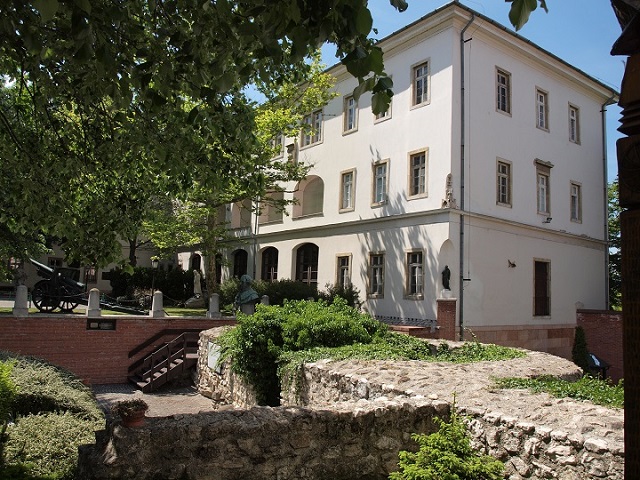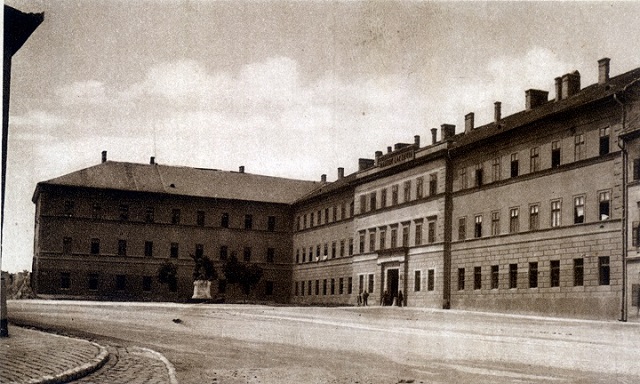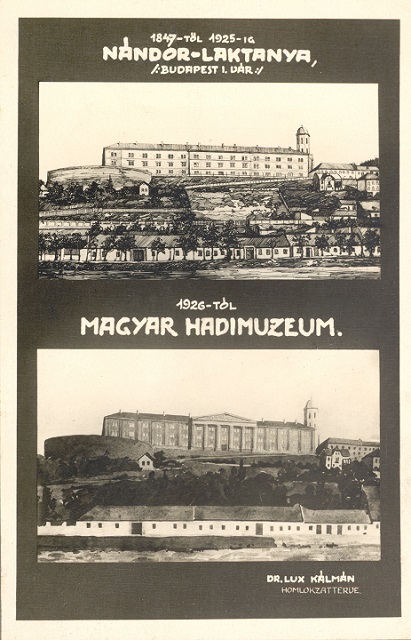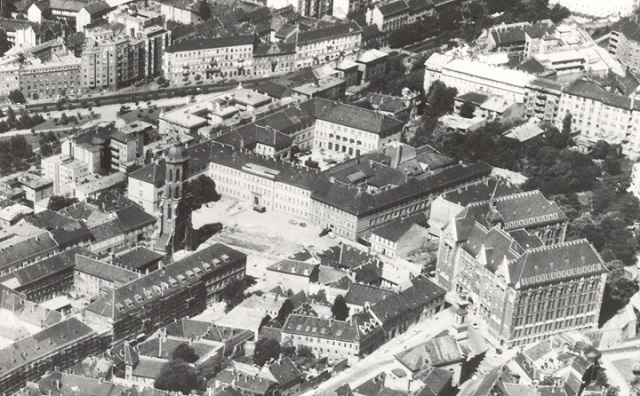The Military History Institute and Museum occupies the north-western corner of the Castle District, on the area surrounded by Kapisztrán Square, Tóth Árpád Promenade, the Esztergom Roundel (Primate Bastion) and the building of the Budavár Municipality. The building preserved its original Classicist profile on the Kapisztrán Square side, while the western and northern frontages facing Tóth Árpád Promenade had been remodelled several times. The excavations conducted in the courtyard between 1987 and 1990 uncovered the remains of the walls, from the time of King Béla IV, of the civil town, which was founded north of the Royal Castle (where the Palace stands today). The foundations of the Museum’s western wing were built on these Medieval walls. South of those, the foundations of two 14th-century Medieval houses were discovered. The remains of the metal casting furnace found near the Castle walls prove that there was industrial activity here in the 13th century. The two houses were rebuilt at least once during the Middle Ages; and they lived to see the Ottoman Period as well. During the Ottoman occupation, houses lined up here densely until 1686, when the besiegers of Buda managed to break into the Castle at this spot first. Therefore, it is no wonder that the maps made after the siege portray this area as derelict.

Remains of the Medieval city walls in the inner courtyard
It is representative of this place’s strategical importance that the 1696 house register of Buda mentions two new barracks (Soldatenhäuser) here, which stood perpendicular to the western bastion wall. Although rebuilt several times, these nonetheless did not satisfy the needs of the military authorities, as the military command wanted to keep up with the large-scale development of the capital during the 19th century. Therefore, the issue of building a new barracks was already discussed in 1841 by the competent military bodies. The demolition of the old barracks and the building of a new, larger one was ordered in 1843.
On the northern side of the square the building of the Budavár Municipality (the former building of the State Press) stands which was built between 1827 and 1834, and originally was the two-storey Classicist-style house of architect Lajos Kimnach. The western wall of this house is linked to the southern wing of the former barracks, which now houses the Military History Institute and the Military History Archives. The western wing of the barracks, the Military History Museum faces Tóth Árpád Promenade with its frontage; and with its shorter, eastern frontage, closes Kapisztrán Square. Construction began in 1844 and was finished in 1847. The officers’ wing (the later southern part, facing Kapisztrán Square) was completely separate from the other ranks’ wing (the western part, parallel to Tóth Árpád Promenade). The competition for the construction of the new barracks was won by József Dankó Jr., architect from Buda. The construction was carried out under the supervision of Major (Eng.) Josef Glaeser who, being the commander of the Buda Fortification Directorate played a vital part in creating and modifying the plans. During the siege of Buda in 1849, the building was hit by numerous cannonballs. In 1869, a stable for fourteen horses was built in the north-eastern corner of the courtyard. The northern wing was completed in 1892, based on the plans of Guido Hoepfner.

The Nándor Barracks in the 1920s (picture postcard)
Modifications for the western (other ranks’) wing began in 1926, according to the plans of István Gyulányi and for the purposes of the Military History Museum. The central, protrusive section of the western frontage received its distinctive, two-storey architecture, along with the gateway of Tuscan order at the entrance. The original stone framed twin windows were unfurled and the window pairs were made into one single opening, while the other ranks’ halls were converted, as much as possible, into exhibition halls. Probably that was when the short, two-storey eastern wing, next to the Budavár Municipality under 1 Kapisztrán Square, was built.

The converted western, former other ranks’ wing was handed over to the Museum in 1929, while the wing facing the square remained a barracks. The first exhibition in the new building was opened on 29 May 1937.
During the Second World War, between December 1944 and February 1945, the building suffered an 80% damage due to hits by bombs, artillery shells and mortar rounds, 30% of the external walls and 75% of the roof structure was destroyed. Only three rooms out of the 53 on the two storeys remained in such condition that with some repairs they remained suitable to house the collection. Reconstructions began in May 1945 and by early September approximately 100 workers were involved in clearing the ruins and construction. In December, eight premises were ready, however half of the building’s roof structure was still absent. Reconstruction works began in 1947 according to the plans of architect Zoltán Legényi, and from 1952 under the supervision of engineer Imre Imrényi Szabó, it continued with a higher pace. First they rebuilt the collapsed southwestern wing. The main frontage facing Kapisztrán Square was reconstructed in its original form, whereas the frontage of the western wing was modified: the gateway of Tuscan order was renewed in Greek Doric style, and on top they applied a Classicist corridor fence from a demolished Hild building as a parapet. The oak-covered parts of the entrance gate were rebuilt in Classicist style. The cannonballs placed into the frontage, symbolizing the Hungarian artillery hits from the siege of 1849, remained unchanged. The Eclectic frontage of the northern wing extension built in 1892 was adjusted to that of the southern wing and its internal layout was changed. For example they formed a two-storey hall on the ground floor. During the reconstruction works, the entire building complex was handed over to the later Military History Institute and Museum.

The building of the Military History Institute and Museum in the 1970s
During the reconstructions, Gothic and Baroque stone carvings were inserted into the frontages facing the courtyard, as decoration. Originally, these were parts of Matthias Church, which were built into the Mary Magdalene Garrison Church when the former was remodelled by Frigyes Schulek. Remains of the latter church, which was damaged in 1945 and later demolished except for its tower, were carried into the Museum.
In 1964, a two-storey storage wing was built in the courtyard, but this did not solve problems of storing. In the 1970s, the construction of a new building was on the agenda again. Due to the finding of Medieval architectural artefacts constructions had to be stopped in 1987, therefore these plans could not be realised.
In 1992–1993, the frontage was repainted from yellow to white. Twenty years later, during 2012–2013, further reconstructions took place in the building. The entire street and courtyard frontage was renewed, the windows were fixed and coated and the entrance hall of the Museum was also transformed.
The building of the MoD Military History Institute and Museum (Nándor Barracks; 2–4 Kapisztán Square; 8 Anjou Promenade; 40 Tóth Árpád Promenade) has been on the official list of monuments since 1949; it is a building complex of outstanding national value and it is under heritage protection.
(The above text is based on the scientific monument documentation by József Sisa.)



